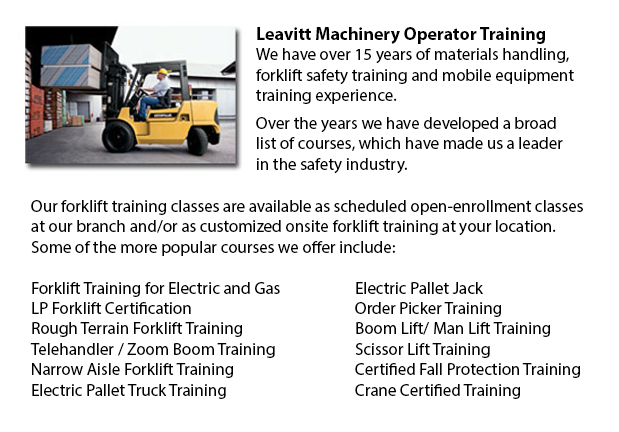
Forklift Training Programs Burlington - If you are searching for a job as an operator of a forklift, our regulatory-compliant forklift training programs provide excellent instruction in many types and styles of forklifts, lessons on pre-shift check, fuel kinds and handling of fuels, and safe utilization of a lift truck. Practical, hands-on training assists participants in acquiring essential operational skills. Program content consists of existing regulations governing the operation of lift trucks. Our proven forklift courses are intended to provide training on these types of trucks: narrow isle forklift, counterbalanced forklift and powered pallet truck.
How to Handle Loads Safely
Whilst the forklift is in use, do not lower or raise the forks. Loads should not extend above the backrest. This is because of the risk of the load sliding back towards the operator. Check for overhead obstructions and make certain there is sufficient clearance before lifting a load. Stay away from overhead power lines. When the load is lifted straight up, tilt it back slightly.
The lift truck is less stable if a load is in a raised position. Make certain that no one ever walks beneath the elevated fork. The operator should not leave the lift truck while the load is lifted.
The forks should be level when handling pallets, and high enough to extend all the way into and below the load. The width of the forks must provide even weight distribution.
Prior to unloading or loading the truck, set the brakes and chock the wheels. Floors have to be strong enough to support the weight of the load and the forklift combined. Fixed jacks can be installed to be able to support a semi-trailer that is not coupled to a tractor. The entrance door height should clear the height of the forklift by a minimum of 5 cm. Edges of ramps, docks and rail cars should be marked and avoid them.
Do not stay in a lift truck for long periods without correct ventilation. The interior of the truck must be properly lighted and free of obstructions, trash and loose objects. Inspect for holes in the floor. The installation of nonslip material on the floor will help avoid slipping. Clear whatever obstacles from docks and dockplates and ensure surfaces are not wet or oily.
Lift trucks should not be used to push or tow other forklifts.
-
Order Picker Training Burlington
Order Picker Training Burlington - Order picker's enables warehouse employees to lift pallets using forks. Also called a stock picker, this particular electrically-powered equipment is similar to a forklift except that an order picker is likewise uti... More -
Crane Certification Burlington
Crane Certification Burlington - The Crane Certification training program includes content recommended by industry regarding the efficient and safe operation of cranes. Trainees would learn the following: how to identify cranes and their component pa... More -
Overhead Crane Training Burlington
Overhead Crane Training Burlington - The overhead crane is a piece of equipment which can lift and move huge, heavy objects which can't be handled by hands. Typically, overhead cranes are fixed in place. These equipment are capable of moving huge vol... More -
Aerial Lift / Boom Lift / Man Lift / Scissor Lift Training in Burlington
Lift tables or scissor lifts could elevate both people and goods vertically. They are normally used in construction, commercial and industrial environments. Commonly, the use of a scissor lift is to lift and lower supplies from one floor of a job loc... More -
Telehandler Operator Training Burlington
Telehandler Operator Training Burlington - Telescopic Handler forklifts or telehandler forklifts are usually found on construction places and their popularity continues to rise. The versatility of telehandler forklifts ensures that they are a valuabl... More -
Forklift Training Classes Burlington
Forklift Training Classes Burlington - Forklift are heavy pieces of industrial machines that are made use of in transporting and the handling of merchandise and materials. They are often known as Lift trucks and are found in all sorts of businesses.... More -
Boom Lift Training Burlington
Boom Lift Training Burlington - Aerial platforms or also known as elevated work platforms are devices that allow workers to perform tasks and duties at elevated heights that would not be otherwise accessible. There are a variety of aerial lifts avail... More -
Bucket Truck Training Burlington
Bucket Truck Training Burlington - The Vehicle-Mounted Aerial Work Platform or also called bucket truck training program is intended to decrease the risk of incident and personal injury while working in close proximity or with bucket trucks by effici... More

Forklift Training Burlington
TOLL FREE: 1-888-254-6157
Burlington, Ontario
forklifttrainingburlington.com
Email Us
About Us


